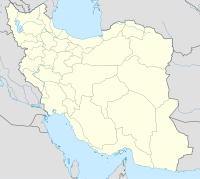Tepe Yahya
| Tepe Yahya | |
|---|---|
| Location in Iran | |
| Coordinates: 28°19′51″N 56°52′03″E / 28.33083°N 56.86750°E |
Tepe Yahya is an archaeological site in Kermān Province, Iran, some 220 km south of Kerman city, 90 km south of Baft city and 90 km south-west of Jiroft.
Habitation spans the 6th to 2nd millennia BCE and the 10th to 4th centuries BCE.
In the 3rd millennium BCE, the city was a production center of chlorite pottery; these carved dark stone vessels have been found in ancient Mesopotamian temples.
"Elaborate stone vessels carved with repeating designs, both geometric and naturalistic, in an easily recognizable “intercultural style”, were made primarily of chlorite; a number were produced at the important site of Tepe Yahya (Yaḥyā) southeast of Kermān in the middle and late 3rd millennium b.c.e. Some of these vessels were painted natural color (dark green) and inlaid with pastes and shell, and some have even been found with cuneiform inscriptions referring to rulers and known Sumerian deities. More than 500 vessels and vessel fragments carved in this style have been recovered from sites ranging from Uzbekistan and the Indus Valley (e.g., Mohenjo-daro) in the east to Susa and all the major Sumerian sites in Mesopotamia, including Mari, in the west and to the Persian Gulf, particularly Tarut and the Failaka Islands, in the south."
In this period, the area was under Elamite influence, and tablets with Proto-Elamite inscriptions were found.
The site is a circular mound, around 20 meters in height and around 187 meters in diameter. It was excavated in six seasons from 1967 to 1975 by the American School of Prehistoric Research of the Peabody Museum of Archaeology and Ethnology of Harvard University in a joint operation with what is now the Shiraz University. The expedition was under the direction of C. C. Lamberg-Karlovsky.
...
Wikipedia

